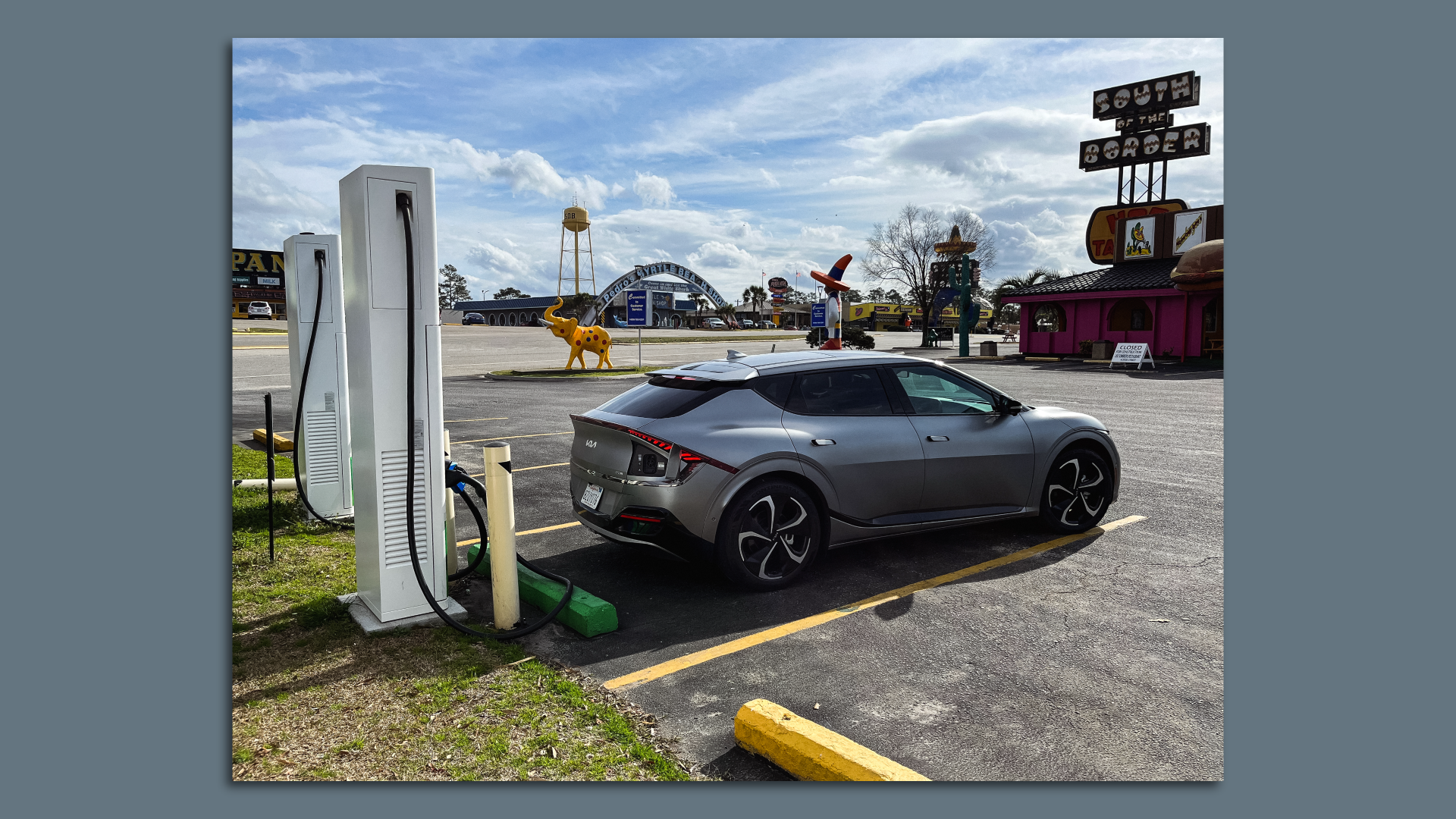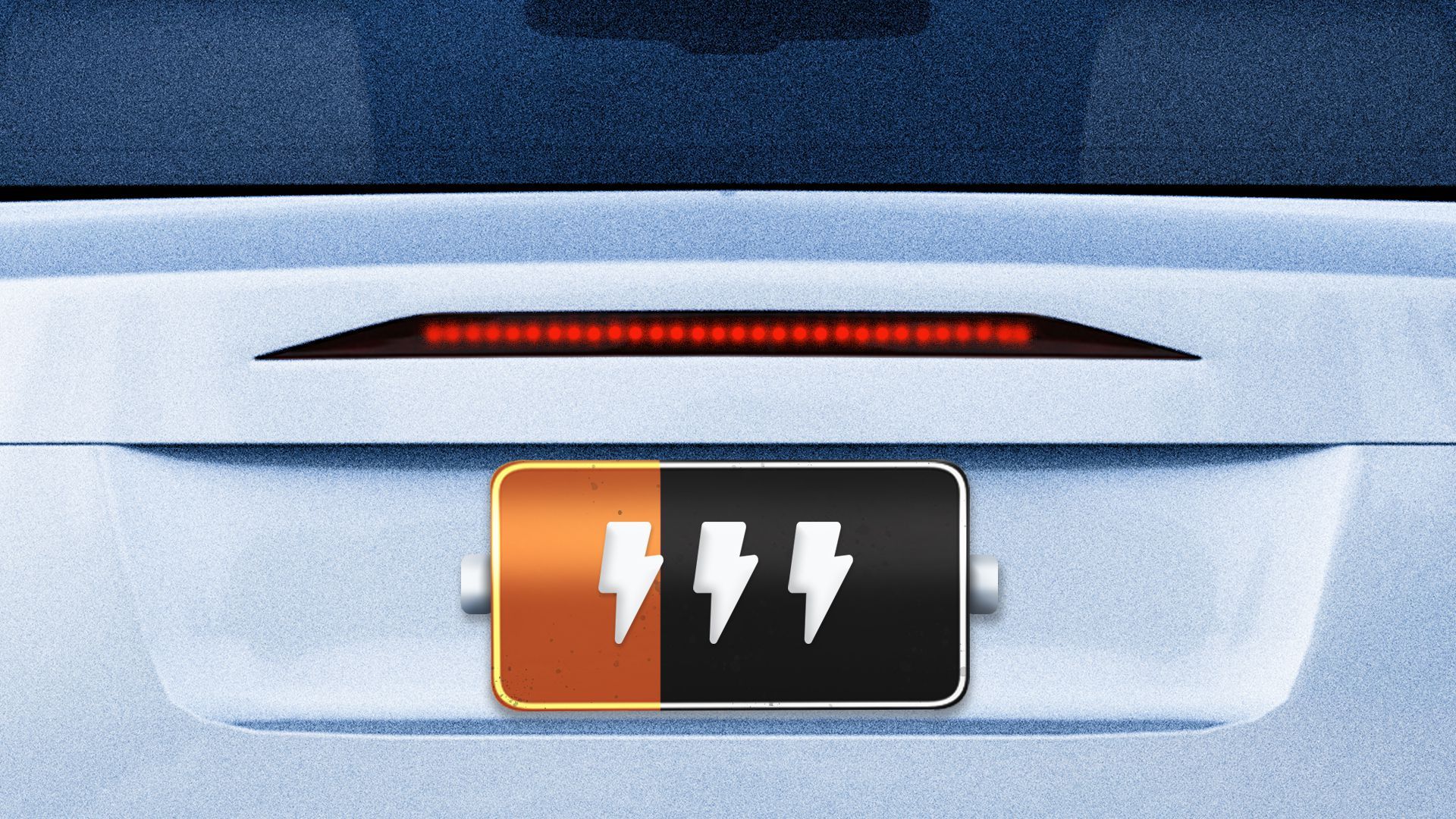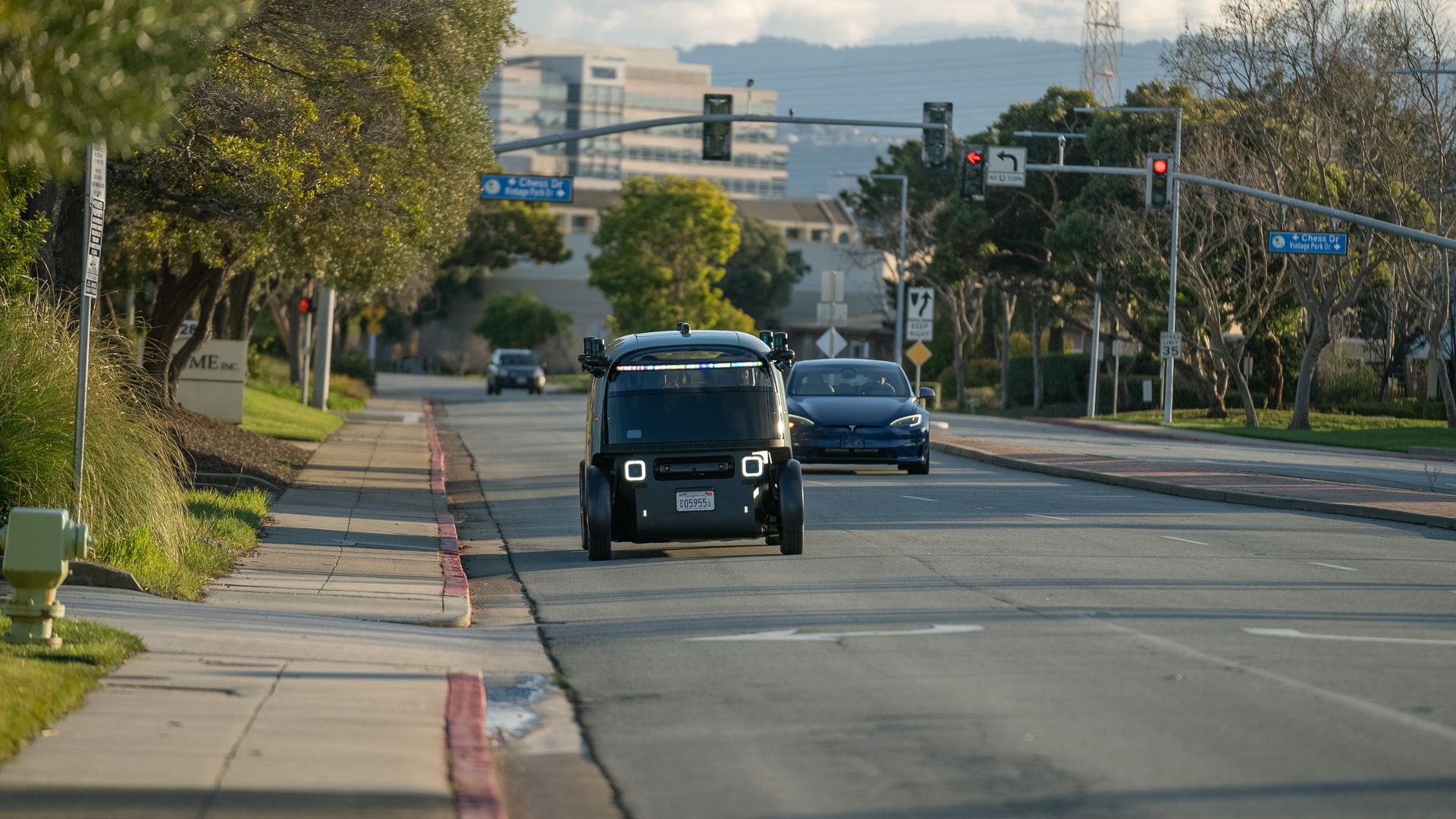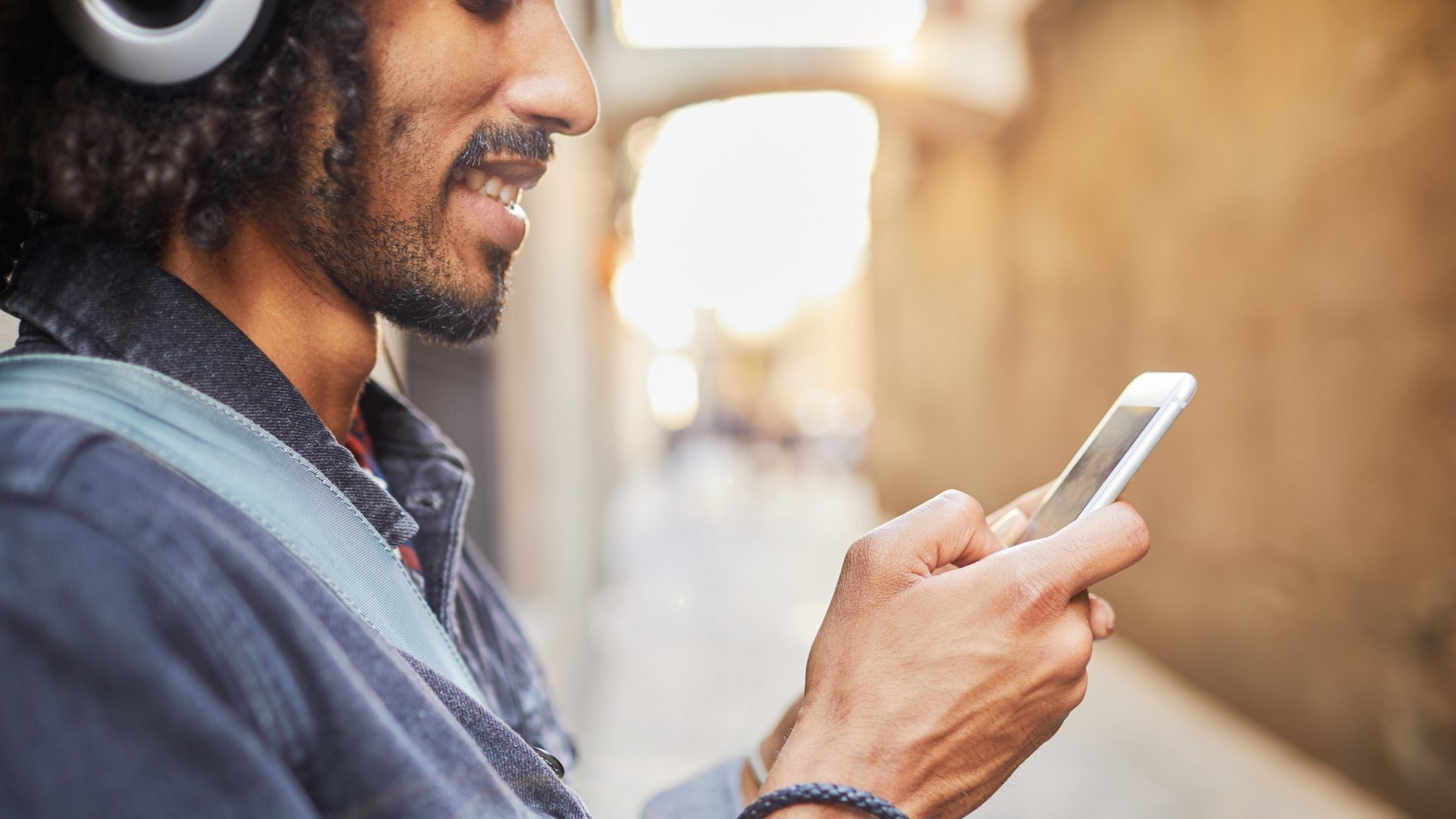| | | | | | | Presented By SiriusXM | | | | Axios What's Next | | By Joann Muller, Jennifer A. Kingson and Alex Fitzpatrick · Feb 14, 2023 | | Are EVs up to the challenge of the great American road trip? Find out in Joann's first report from her recent epic interstate drive. - Join Axios Thursday at 12:30 p.m. ET for a virtual event examining the future of the music industry. Guests include Grammy-nominated DJ, producer and entrepreneur Steve Aoki, and Audius co-founder Roneil Rumburg.
Today's newsletter is 1,130 words ... 4.5 minutes. | | | | | | 1 big thing: EV road trippin' |  | | | Joann and Bill recharged their Kia EV6 at a roadside attraction in South Carolina called South of the Border. Photo: Joann Muller | | | | A long road trip in an electric vehicle (EV) is entirely doable — but not without its challenges, as Joann Muller writes. - My husband and I drove from Michigan to Florida in a Kia EV6 — 1,500 miles in all — to see if America is ready for the era of electric transportation.
- The answer: not quite, but we're making progress.
Why it matters: EVs account for about 5% of new car sales, and just 1% of all cars on the road. What we found: You can make a long road trip without fear of getting stranded, as long as you plan ahead. - That means juggling route-planning apps and billing accounts with various charging companies, which can get confusing.
- And be prepared for the unexpected, like glitchy charging equipment touchscreens, billing questions and inoperable plugs.
First, the car: The EV6 is a great choice for a road trip because its 800-volt charging system makes it among the fastest charging EVs available today. - At a 350 kW DC fast-charger, the EV6's battery can go from 10% to 80% (good for up to 217 miles) in under 18 minutes, according to Kia.
- It's also roomy and comfortable, with lots of advanced technology — including a heads-up display with augmented reality and various driver assistance technologies.
Details: My husband, Bill, set out from Detroit last Tuesday in the all-wheel-drive EV6 GT-Line, which has an EPA-estimated battery range of 274 miles. - The plan was to meet up in Washington, D.C., and then travel together to Winter Garden, Florida.
- His first recharging stop was at an Electrify America station outside Cleveland, per the advice of an app called A Better Route Planner. But he was anxious about the car's driving range.
 Data: Joann Muller; Map: Erin Davis/Axios Visuals What he said: "When I left Detroit, the temperatures were in the low 30s and the vehicle said it had a range of 216 miles. A Kia engineer told us that the cold would put extra stress on the battery, draining it faster than normal. So I used only the heated steering wheel and heated seats while driving — no cabin heat." - After a chilly 151 miles, he arrived at the recharging spot with 16% left on the battery, which helped him get over his range anxiety.
- "But I did learn a lesson: Know where your next charging stop is before you leave, and make sure to have extra range upon arrival in case that charger is inoperable."
This was a leisurely trip, with stops to visit friends and do some sightseeing. If we cannonballed from Michigan to Florida, it would have taken about 24 hours. We did it over four days. - But we were constantly thinking about where to charge next. It occupied our minds more than where to eat or spend the night.
- We stopped 12 times to recharge over the 1,500-mile journey. Charging times varied between 20 minutes and 55 minutes, depending on the state of the car's battery and the speed of the chargers we used.
The bottom line: Gradually, our confidence grew. We never felt range anxiety again — even when the battery level fell below 10% and the dashboard flashed orange warnings. What's next: We'll be heading north again in a few weeks on a different route, so stay tuned. Share this story. |     | | | | | | 2. Ford's battery factory will use Chinese tech |  | | | Illustration: Sarah Grillo/Axios | | | | Ford Motor is investing $3.5 billion in a Michigan factory that will make electric vehicle batteries using technology licensed from a major Chinese supplier, Joann reports. Why it matters: The plant, which is expected to create 2,500 high-paying jobs, is part of a burgeoning U.S. supply chain for electric vehicles (EVs) — but it comes amid heightened geopolitical tensions between the U.S. and China. Details: The plant in Marshall, a rural town about 100 miles west of Detroit, will make battery cells using technology from Contemporary Amperex Technology Co., Limited (CATL), the world's largest producer of EV batteries. - The so-called LFP batteries (for lithium, iron and phosphate) are less expensive because they don't include minerals like cobalt and nickel. That will help bring down the cost of electric cars.
- LFP batteries are also more durable, but they provide a shorter driving range, creating a tradeoff for consumers.
Read the rest. |     | | | | | | 3. Rise of the "anti-influencers" |  | | | Illustration: Gabriella Turrisi/Axios | | | | Millions of people have built careers out of "influencing" — essentially, getting the rest of us to buy things. Now a new trend is on the rise, Axios' Erica Pandey reports: "de-influencing." - On TikTok and Instagram, an increasing number of influencers are using their platforms to tell fans what not to buy, pushing back against the growing pressure to spend more and more cash to hop on viral trends.
Why it matters: It's a threat to the $16 billion influencer marketing economy — and a recognition that many people are struggling financially. What they're saying: "We're seeing social commerce go through a recession for the first time," says Chris Beer, an analyst at audience research firm GWI. By the numbers: The number of Gen Zers interested in influencers has dropped 12% since 2020, and the number who take note of what influencers wear has fallen 16%, per GWI data. - As a result, influencers are making viral videos listing trendy makeup products or shoes that aren't worth the money, or what to cut when planning trips or weddings.
What we're watching: Whether Gen Z's consumption fatigue outlasts the current economic situation. Share this story. |     | | | | | | A message from SiriusXM | | Get free access to music, sports, news and more | | |  | | | | Subscribe to SiriusXM Streaming and get access to 3 months of free: - Expertly curated ad-free music.
- Pandora artist stations.
- Live sports.
- Celebrity hosts, comedians and newscasters.
- Howard Stern and more.
More info: Listen on your phone, at home and more with the SXM App. See offer details. | | | | | | 4. 📸 Zoox's robotaxi rolls out |  | | | Photo courtesy of Zoox | | | | Autonomous transportation startup Zoox's purpose-built robotaxi is now rolling on open public roads, the Amazon-owned company announced Monday. - The milestone took the form of an employee shuttle run in Foster City, California.
- Zoox also has been testing its technology on retrofitted cars in San Francisco.
- Its robotaxis were confined to private roads before getting the OK from California regulators to drive on public streets.
The big picture: Other companies, such as General Motors' Cruise and Alphabet's Waymo, have rolled out autonomous robotaxi services with modified versions of traditional vehicles. - Both plan to deploy robotaxis built from the ground up for autonomous use.
|     | | | | | | 5. One fun thing: Testing ChatGPT's local cred |  | | | Illustration: Maura Losch/Axios | | | | Axios Houston's Jay R. Jordan and Shafaq Patel recently put generative AI platform ChatGPT's knowledge of their city to the test. - While they weren't happy with its pick for best taco spot, its other knowledge of the city was pretty spot on.
- "It's certainly in tune with the city's needs, having pegged some of the top issues plaguing Houstonians: Traffic congestion, affordable housing, flooding, air pollution, crime, income inequality and health care," they write.
One fun thing: It also knows how to sell the city to outsiders. - "Make Houston your new home today! With its combination of a strong job market, affordable cost of living and rich cultural scene, Houston is the perfect place to live, work and play."
Read the rest. |     | | | | | | A message from SiriusXM | | Stream SiriusXM now and get 3 months for free | | |  | | | | Stream more than 425 channels on your devices for free on the SXM App, including expertly curated ad-free music, live sports, personalized stations and more. Next steps: Sign up now to get 3 months free. Cancel anytime. Learn more about the offer and start streaming. See offer details. | | | | Big thanks to What's Next copy editor Amy Stern. Was this email forwarded to you? Get your daily dose of What's Next by signing up here for our free newsletter. |  | | Are you a fan of this email format? Your essential communications — to staff, clients and other stakeholders — can have the same style. Axios HQ, a powerful platform, will help you do it. | | | | | | Axios thanks our partners for supporting our newsletters.
Sponsorship has no influence on editorial content. Axios, 3100 Clarendon Blvd, Arlington VA 22201 | | | You received this email because you signed up for newsletters from Axios.
To stop receiving this newsletter, unsubscribe or manage your email preferences. | | | Was this email forwarded to you?
Sign up now to get Axios in your inbox. | | | | Follow Axios on social media:    | | | | | |










No comments:
Post a Comment